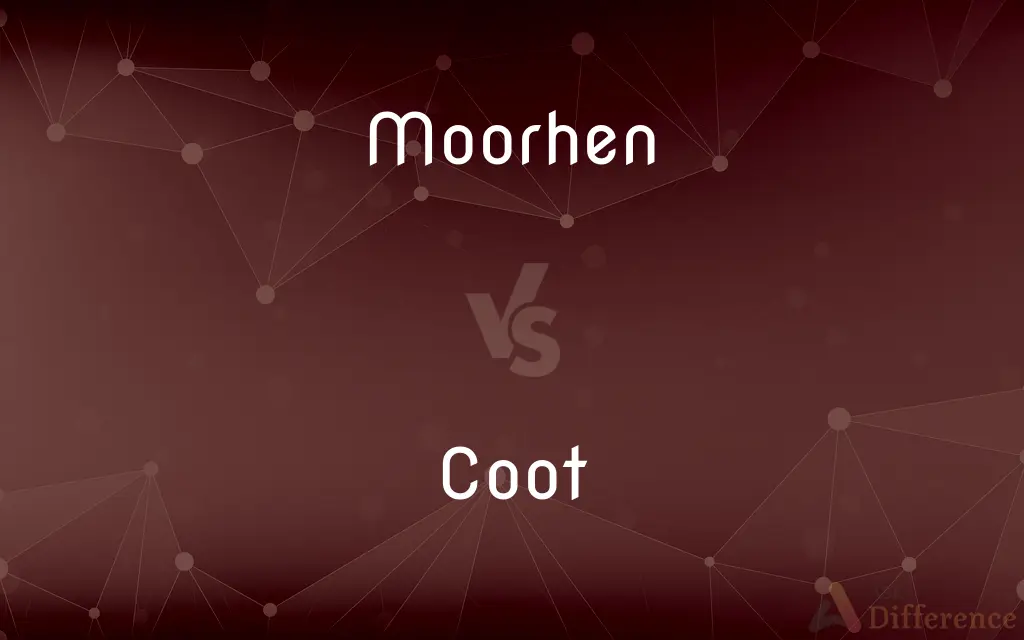Moorhen vs. Coot — What's the Difference?
By Fiza Rafique & Urooj Arif — Updated on March 26, 2024
Moorhens, known for their red and yellow beaks, thrive in wetlands with abundant vegetation. Coots, recognized by their white beaks and bald frontal shields, prefer more open water spaces.

Difference Between Moorhen and Coot
Table of Contents
ADVERTISEMENT
Key Differences
Moorhens, part of the rail family, are distinguishable by their striking red and yellow beaks and greenish-black bodies. They exhibit a preference for dense vegetation near water bodies, where they can easily hide from predators. Their feet are not webbed, featuring long toes that help them walk on soft ground and vegetation. Coots, also belonging to the rail family, stand out with their white beaks and prominent white frontal shields, contrasting against their dark plumage. Unlike moorhens, coots have lobed toes, which assist them in swimming in open waters where they predominantly reside.
While both species are omnivorous, feeding on a variety of plant material, insects, and small fish, their feeding habits reflect their habitat preferences. Moorhens, with their more secretive nature, forage within the safety of vegetation. In contrast, coots are bolder, frequently seen foraging in open waters or even on land.
Reproduction strategies of both species also mirror their environmental adaptations. Moorhens carefully construct their nests in sheltered, vegetated areas to conceal them from predators, laying eggs that are well camouflaged. Coots, on the other hand, build floating nests in open water, relying on the safety provided by the water and their social nature to protect against threats.
Despite these differences, both moorhens and coots demonstrate remarkable adaptability to their environments. Their presence in a variety of wetlands across many regions attests to their resilience and the critical role they play in aquatic ecosystems.
Comparison Chart
Beak Color
Red and yellow
White
ADVERTISEMENT
Body Color
Greenish-black
Dark plumage
Habitat Preference
Dense vegetation near water bodies
Open waters of lakes and reservoirs
Feet Type
Long toes, not webbed
Lobed toes for swimming
Social Behavior
Less social, more secretive
More social and aggressive, often seen in large groups
Nesting
Nests hidden among reeds or bushes, in sheltered areas
Builds floating nests in open water
Feeding
Omnivorous, prefers foraging within vegetation
Omnivorous, forages in open water and on land
Distribution
Wetlands, marshes, ponds, streams
Larger bodies of water like lakes, more open spaces
Compare with Definitions
Moorhen
A waterbird with a red and yellow beak, thriving in vegetated wetlands.
The moorhen darted into the reeds at the slightest sound.
Coot
Forms large, noisy groups, especially in winter.
The lake was bustling with a large flock of coots.
Moorhen
Prefers secluded areas for nesting.
A moorhen's nest, hidden in the brush, contained five speckled eggs.
Coot
A waterbird recognizable by its white beak and bald frontal shield.
The coot dove underwater, emerging seconds later with a fish.
Moorhen
Known for walking on vegetation with long toes.
Moorhens were spotted foraging along the marsh's edge.
Coot
More aggressive in defending territory.
A coot chased away intruders from its nesting area aggressively.
Moorhen
Less social compared to coots.
A solitary moorhen was observed beside the pond at dawn.
Coot
Constructs floating nests in open waters.
Coots were seen gathering materials for their nests amid the reeds.
Moorhen
Adaptable to various freshwater habitats.
Moorhens have adapted to living in urban park ponds.
Coot
Has lobed toes for efficient swimming.
A group of coots paddled smoothly across the lake's surface.
Moorhen
Moorhens—sometimes called marsh hens—are medium-sized water birds that are members of the rail family (Rallidae). Most species are placed in the genus Gallinula, Latin for "little hen".
Coot
Coots are medium-sized water birds that are members of the rail family, Rallidae. They constitute the genus Fulica, the name being the Latin term for "coot." Coots have predominantly black plumage, and—unlike many rails—they are usually easy to see, often swimming in open water.
Moorhen
A widely distributed gallinule (Gallinula chloropus) having a black body and a red and yellow bill that extends up onto the forehead.
Coot
An aquatic bird of the rail family, with blackish plumage, lobed feet, and a bill that extends back on to the forehead as a horny shield.
Moorhen
Any of various medium-sized water birds of the genus Gallinula, of the rail family, that feed in open water margins.
Coot
A stupid or eccentric person, typically an old man.
Moorhen
(British) A female red grouse, Lagopus lagopus scotica.
Coot
Any of several waterbirds of the widely distributed genus Fulica, having dark-gray plumage, a black head and neck, and often a white bill.
Moorhen
A black gallinule (Gallinula chloropus) that inhabits ponds and lakes.
Coot
See scoter.
Moorhen
The female of the moor fowl; the moor hen.
Coot
(Derogatory) An eccentric or crotchety person, especially an old man.
Moorhen
Black gallinule that inhabits ponds and lakes
Coot
Any of various aquatic birds of the genus Fulica that are mainly black with a prominent frontal shield on the forehead.
Moorhen
Female red grouse
Coot
(colloquial) A foolish or eccentric fellow
An old coot
A rich coot
Coot
A success; something excellent.
Man that song's the coot.
Would be the coot if we could go this weekend!
Coot
(slang) Body louse (Pediculus humanus).
Coot
A wading bird with lobate toes, of the genus Fulica. The common European or bald coot is Fulica atra (see under bald); the American is Fulica Americana
Coot
A stupid fellow; a simpleton; as, a silly coot.
Coot
Slaty-black slow-flying birds somewhat resembling ducks
Common Curiosities
What distinguishes a moorhen's appearance from a coot's?
Moorhens have red and yellow beaks and greenish-black bodies, while coots have white beaks, bald frontal shields, and dark plumage.
Can moorhens swim as well as coots?
While moorhens can swim, their long toes are more adapted for walking on soft ground and vegetation, making coots more efficient swimmers due to their lobed toes.
How do moorhens and coots contribute to their ecosystems?
As part of the aquatic food web, they control insect populations, contribute to the spread of plant seeds, and serve as prey for larger predators.
What kind of feet do coots have?
Coots have lobed toes, aiding them in swimming in their preferred open water habitats.
What are the nesting habits of coots?
Coots build floating nests in open water, contrasting with the moorhens' preference for hidden, vegetated areas.
How do moorhens and coots differ in their social behavior?
Moorhens are less social and more secretive, whereas coots are more aggressive, social, and often found in large groups.
Where do moorhens prefer to live?
Moorhens thrive in wetlands with dense vegetation, allowing them to hide from predators.
Why are coots more aggressive than moorhens?
Coots' aggressiveness is likely a response to their open water habitat, where defending territory and nests from predators and rivals is crucial.
Do moorhens and coots eat the same food?
Both are omnivorous, but their feeding habits reflect their habitat preferences, with moorhens foraging within vegetation and coots being bolder in open waters.
Are moorhens and coots found in the same geographical regions?
While both can be found in various parts of the world, their specific habitat preferences determine their presence in particular wetlands or water bodies.
Share Your Discovery

Previous Comparison
Then vs. Thereafter
Next Comparison
Specialist vs. ExecutiveAuthor Spotlight
Written by
Fiza RafiqueFiza Rafique is a skilled content writer at AskDifference.com, where she meticulously refines and enhances written pieces. Drawing from her vast editorial expertise, Fiza ensures clarity, accuracy, and precision in every article. Passionate about language, she continually seeks to elevate the quality of content for readers worldwide.
Co-written by
Urooj ArifUrooj is a skilled content writer at Ask Difference, known for her exceptional ability to simplify complex topics into engaging and informative content. With a passion for research and a flair for clear, concise writing, she consistently delivers articles that resonate with our diverse audience.














































